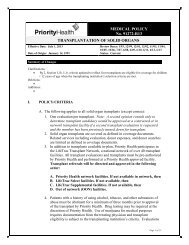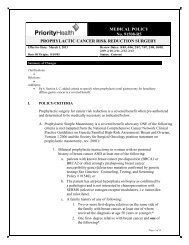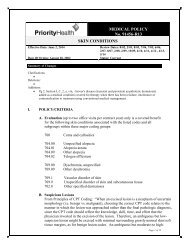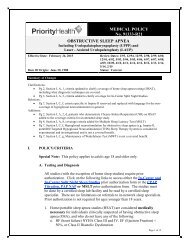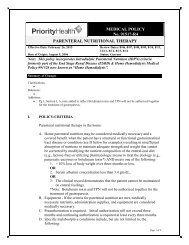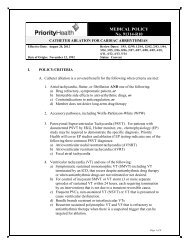Tinnitus Retraining Therapy - 91482 - Priority Health
Tinnitus Retraining Therapy - 91482 - Priority Health
Tinnitus Retraining Therapy - 91482 - Priority Health
Create successful ePaper yourself
Turn your PDF publications into a flip-book with our unique Google optimized e-Paper software.
MEDICAL POLICYNo. <strong>91482</strong>-R0TINNITUS RETRAINING THERAPYEffective Date: April 28, 2004 Review Dates: 4/04, 5/04, 7/05, 6/06, 6/07, 6/08, 6/09,6/10, 6/11, 6/12, 6/13, 5/14Date Of Origin: April 28, 2004Status: CurrentI. POLICY/CRITERIA<strong>Tinnitus</strong> retraining therapy for the treatment of tinnitus has not been shown to beeffective in peer reviewed medical literature. This approach is consideredinvestigational and unproven and is not a covered benefit.II.MEDICAL NECESSITY REVIEWRequired Not Required Not ApplicableIII. APPLICATION TO PRODUCTSCoverage is subject to member’s specific benefits. Group specific policy willsupersede this policy when applicable. HMO/EPO: This policy applies to insured HMO/EPO plans. POS: This policy applies to insured POS plans. PPO: This policy applies to insured PPO plans. Consult individual plan documents as statemandated benefits may apply. If there is a conflict between this policy and a plan document,the provisions of the plan document will govern.. ASO: For self-funded plans, consult individual plan documents. If there is a conflictbetween this policy and a self-funded plan document, the provisions of the plan document willgovern. INDIVIDUAL: For individual policies, consult the individual insurance policy. If there is aconflict between this medical policy and the individual insurance policy document, theprovisions of the individual insurance policy will govern. MEDICARE: Coverage is determined by the Centers for Medicare and Medicaid Services(CMS); if a coverage determination has not been adopted by CMS, this policy applies. MEDICAID: For Medicaid members, this policy will apply. Coverage is based on medicalnecessity criteria being met and the appropriate code(s) from the coding section of this policybeing included on the Michigan Medicaid Fee Schedule located at:http://www.michigan.gov/mdch/0,1607,7-132-2945_42542_42543_42546_42551-159815--,00.html. If there is a discrepancy between this policy and the Michigan Medicaid ProviderManual located at: http://www.michigan.gov/mdch/0,1607,7-132-2945_5100-87572--,00.html, the Michigan Medicaid Provider Manual will govern. For MedicalSupplies/DME/Prosthetics and Orthotics, please refer to the Michigan Medicaid FeeSchedule to verify coverage. MICHILD: For MICHILD members, this policy will apply unless MICHILD certificate ofcoverage limits or extends coverage.Page 1of 4
MEDICAL POLICYNo. <strong>91482</strong>-R0<strong>Tinnitus</strong> <strong>Retraining</strong> <strong>Therapy</strong>IV. DESCRIPTION<strong>Tinnitus</strong> retraining therapy (TRT) is a neurophysiological approach centering onbehavioral retraining of the associations induced by perception of tinnitus. It usesdevices similar to tinnitus maskers. These devices, known as white noisegenerators, produce white noise, and are used over a period of several months tohelp patients in their habituation of tinnitus. Measurement of the tinnitus match isperformed after an audiogram. The patient is asked to identify which of the tones ofthe audiometer match the tone of the ringing of his or her tinnitus. Examples ofmeasures quantified include pitch, loudness and minimal masking level of thetinnitus. These parameters are then used for tinnitus retraining and for selectingdevices, which can produce "white noise" to counterbalance and reduce oreliminate the tinnitus. (Aetna Clinical Policy Bulletin, Number 0406)Background:<strong>Tinnitus</strong> retraining, also referred to as tinnitus habituation therapy, is a treatmentoption based on the theories of a researcher named Jastreboff. Jastreboff proposesthat tinnitus itself is related to the normal background electrical activity in auditorynerve cells, but the key factor is the subject's unpleasant perception of the noise,which is governed by an abnormal conditioned response in the extra-auditorylimbic system. <strong>Tinnitus</strong> retraining focuses counseling and behavioral retraining onthe associations induced by tinnitus perception. Specifically, the goal is not toeliminate the tinnitus itself, but to retrain the subcortical and cortical centersinvolved in processing the tinnitus signals. The counseling may require four to sixone-hour visits over an 18-month period. As part of the overall therapy, maskersare used to induce habituation to the tinnitus. In contrast to the typical use ofmaskers, in retraining therapy, the masker is not intended to drown out or mask thetinnitus, but is set at a level such that the tinnitus can still be detected. This strategyis thought to enhance habituation by increasing the neuronal activity within theauditory system such that the tinnitus is difficult to detect. (The Regence Group).Most of the published scientific literature related to TRT consists of explanations ofthe neurophysiologic model on which this therapy is based. Although there arereports of a nearly 80% success rate with this treatment, these reports are basedsolely on patient surveys from a select group of patients who received TRT at oneof two treatment centers. There are no published randomized clinical trialscomparing TRT to existing, albeit unsatisfactory treatment options, nor arecomparisons made to sham treatment. Jastreboff and colleagues report improvedoutcomes with TRT compared to counseling alone for patients treated in theirclinic; however, this data was based on post-treatment patient surveys, and thesepatients were not treated under a formal research protocol. Treatment choices werebased, not on randomization, but on patient preference or financial ability to pay forTRT, thus introducing selection bias into the reported results. Based on the lack ofcontrolled studies comparing TRT to existing or sham treatment, conclusionsPage 2 of 4
MEDICAL POLICYNo. <strong>91482</strong>-R0<strong>Tinnitus</strong> <strong>Retraining</strong> <strong>Therapy</strong>cannot be drawn concerning the health outcome effects of tinnitus retrainingtherapy.Randomized, controlled clinical studies that include no-treatment and placebogroups are needed to ascertain the effectiveness of TRT in the management ofpatients with tinnitus.V. CODING INFORMATIONICD-9 Codes that apply to this policy (for dates of service on or before September 30, 2015):388.30 Unspecified tinnitus388.31 Subjective tinnitus388.32 Objective tinnitusICD-10 Codes that apply to this policy (for dates of service on or after October 1, 2015):H93.11 <strong>Tinnitus</strong>, right earH93.12 <strong>Tinnitus</strong>, left earH93.13 <strong>Tinnitus</strong>, bilateralH93.19 <strong>Tinnitus</strong>, unspecified earHCPCS/CPT Procedure Codes:92700 Unlisted otorhinolaryngological service or procedure97039 Unlisted modality (specify type and time if constant attendance)V5298 Hearing aid, not otherwise classifiedV5299 Hearing service, miscellaneousE1399 Durable medical equipment, miscellaneousExplanatory notes must accompany claims billed with these codesVI.REFERENCES“<strong>Tinnitus</strong> <strong>Retraining</strong> <strong>Therapy</strong>”, Aetna Clinical Policy Bulletins Number: 0406,January 10, 2003.Available at http://www.aetna.com/cpb/data/CPBA0406.html(Retrieved 12-8-03 and May 11, 2007)“Treatment of <strong>Tinnitus</strong>” Policy, The Regence Group, 10/07/2003, Available on theWorld Wide Web at:http://www.regence.com/trgmedpol/allied<strong>Health</strong>/ah25.html (Retrieved 12-8-03and May 11, 2007)Page 3 of 4
MEDICAL POLICYNo. <strong>91482</strong>-R0<strong>Tinnitus</strong> <strong>Retraining</strong> <strong>Therapy</strong>AMA CPT Copyright Statement:All Current Procedure Terminology (CPT) codes, descriptions, and other data are copyrighted by theAmerican Medical Association.This document is for informational purposes only. It is not an authorization, certification, explanation ofbenefits, or contract. Receipt of benefits is subject to satisfaction of all terms and conditions of coverage.Eligibility and benefit coverage are determined in accordance with the terms of the member’s plan in effectas of the date services are rendered. <strong>Priority</strong> <strong>Health</strong>’s medical policies are developed with the assistanceof medical professionals and are based upon a review of published and unpublished information including,but not limited to, current medical literature, guidelines published by public health and health researchagencies, and community medical practices in the treatment and diagnosis of disease. Because medicalpractice, information, and technology are constantly changing, <strong>Priority</strong> <strong>Health</strong> reserves the right to reviewand update its medical policies at its discretion.<strong>Priority</strong> <strong>Health</strong>’s medical policies are intended to serve as a resource to the plan. They are not intended tolimit the plan’s ability to interpret plan language as deemed appropriate. Physicians and other providersare solely responsible for all aspects of medical care and treatment, including the type, quality, and levelsof care and treatment they choose to provide.The name “<strong>Priority</strong> <strong>Health</strong>” and the term “plan” mean <strong>Priority</strong> <strong>Health</strong>, <strong>Priority</strong> <strong>Health</strong> Managed Benefits,Inc., <strong>Priority</strong> <strong>Health</strong> Insurance Company and <strong>Priority</strong> <strong>Health</strong> Government Programs, Inc.Page 4 of 4



